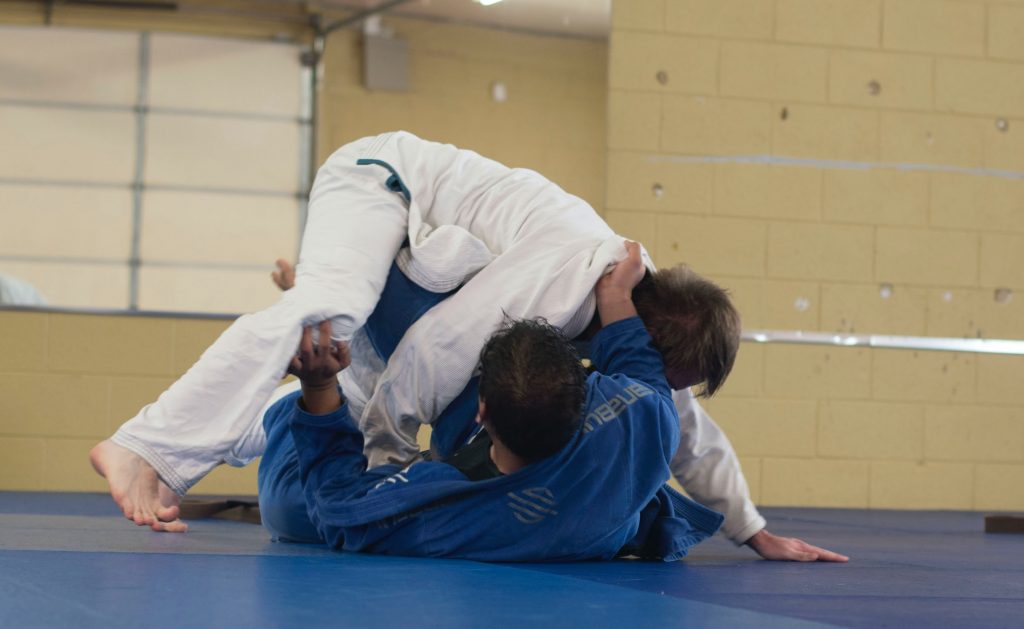Guard passing can be very hard to learn, but it’s very important to become good at BJJ. One thing that helps a lot is to be aware of which guard passes there are. Once you open your eyes to all the possibilities, you’ll glide through guards by taking what your opponent gives you (instead of getting tunnel vision). So let’s take a look at all the BJJ guard passes you can use.
Table of Contents

What is a guard pass?
A guard pass is a way in which you get passed your opponent’s guard. You complete a guard pass when you get past your opponent’s legs and hold him in a pin for at least 3 seconds. In most tournaments you get points for this.
How to pass guard in 2 Simple steps
There’s two steps to guard passing in BJJ:
- Escape the guard you’re in (such as closed guard, worm guard, single leg x guard, etc.)
- Do a guard pass (such as a knee slice, leg drag, etc.)
These two aspects sometimes happen at the same time, and sometimes you don’t need both. It’s actually ideal if you can skip the first step. But very often you first need to escape from your opponent’s guard, and then you can go for a pass.
How to master guard passing in BJJ
To become a black belt at guard passing, you need to master 3 skills:
- Escaping guards by breaking grips and disentangling hooks
- Avoiding sweeps and submissions by having great balance and solid position at all times
- Attacking and combining guard passes
And you should begin with attacking and combining guard passes so you can put pressure on your opponents. And you don’t need to learn all guard passes right away. In Blue Belt in 1 Day you can learn which guard passes work best for beginners and why.
Which guard pass works against which guard?
You can pass almost any guard with any guard pass. The combinations are endless, especially if you go through intermediate positions (like the headquarters position) or if you disentangle all the grips first.
Nevertheless, some guard passes work naturally against some guard positions. Here’s an overview of such combinations:
| Guard | Guard Pass |
| Closed guard | Knee slide, near side knee through, double under pass |
| Half guard | Knee slide, leg weave, over/under pass |
| De la riva guard | Knee slide, smash pass, leg drag |
| Reverse de la riva guard | Knee slide, X pass, leg drag |
| Butterfly guard | Smash pass |
| Single x guard | Back step pass, knee slide |
| X guard | Back step pass, long step |
| Spider guard | Throw by pass |
| Lasso guard | Toreando, knee slide |
Also read: All Guards in BJJ: an exhaustive list
1. Toreando / Toreada / Bull fighter pass
Works against: open guard
One of the most versatile and widely used guard passes is the Toreando or bull fighter pass. It’s called the bull fighter pass because a common variation is that you push your opponent’s legs towards him, and when he pushes back, you step to the side with perfect timing like a bull fighter against a bull.
In reality there are many variations of the Toreando, which all suit slightly different situations, grips and postures of your opponent. But what all Toreandos have in common is that you hold your opponent’s legs and pass around them.
2. Knee slide / Knee Slice / Knee cut / Knee through pass
Works against: half guard, reverse de la riva, de la riva
The knee slide (also called the knee cut or knee through pass) is a guard pass that is often used at the highest levels of BJJ competition. It’s usually initiated from a position in which one of the opponent’s legs is trapped in between the passer’s legs, such as reverse de la riva or half guard.
Knee slides are very versatile, as they can be performed either with speed or with pressure, and with many different grips and weight distributions. They’re also one of the most common guard pass techniques at the black belt level. This makes knee slides a must have tool for guard passers in BJJ.
3. Near side knee through
Works against: de la riva, headquarters position, closed guard
The near side knee through pass is similar to the knee slide, but the difference is that in the knee slide you pass to the opposite side of the leg you’re using, and in the near side knee through you pass to the side of the leg you’re pushing through the guard. An advantage of the near side knee through compared to the knee slide is that you don’t necessarily need to step over one of your opponent’s legs first.
4. leg drag
Works against: open guard, de la riva guard,
In the leg drag you drag one of your opponent’s legs across your body to get passed it. It’s an around-the-legs pass and is often combined with other around-the-legs passes such as the Toreando pass.
5. Smash pass
Works against: half guard, headquarters, half guard
The smash pass is a pressure pass in which you smash your opponent’s legs together with your body weight. There’s different variations, but usually you use your chest, belly or your hip to lay heavily on both of your opponent’s legs. If you do the smash pass right, your opponent won’t be able to move his legs at all, which will give you a free pathway to pass either to the mount or to his back.
6. Leg weave pass
Works against: open guard, half guard
The leg weave pass is similar to the smash pass, but instead using your hips or belly to smash your opponent’s legs to the floor, you use your shoulder. The advantage of this is that your legs are free to move around your opponent, and the drawback is that you naturally have less pressure.
7. Throw by
Works against: spider guard, spider lasso guard, open guard
For the throw by grab one of your opponent’s gi pants and throw that leg explosively past your body. The difference with the leg drag is that for the throw by you stand up straight and thus use all your dead lift muscles to get the leg passed you explosively. But, you can also use the throw by and then drop down again to stabilize in a leg drag position.
8. Over under pass
Works against: half guard
The over under guard pass is so called because you have one arm under and one arm over your opponent’s legs.
The over under is a classic pressure pass and is usually initiated from some kind of half guard. Bernardo Faria is famous for using it a lot in competition.
9. Double under pass
Works against: open guard, half guard, closed guard (after you break it open)
For the double under pass you pass both your arms under your opponent’s legs, and then you usually try to stack him. From the stacked position, you get a thumb-in cross collar grip and use that to push your opponent’s legs out of the way.
Alternatively, you can use the double under to set up the stack position and then pass in some other way, such as with a leg drag.
10. Long step
Works against: single x guard, headquarters, reverse de la riva
The long step is an explosive guard pass. Because it’s so explosive, it’s also one of the harder passes to learn. To do the long step pass, you switch you hips to launch one of your legs far out of your opponent’s guard, while landing with strong upper body pressure (for example with a good cross face). Although the long step is hard to learn, it’s one of the passes you see the most at the black belt level.
11. Cross grip / Crazy dog pass
Works against: open guard
The cross grip pass is one of the strongest passes in Brazilian jiu jitsu according to Keenan Cornelius. What’s great about it is that as soon as you get a cross grip on your opponent’s gi pants, it becomes hard for your opponent to set up a good guard.
The cross grip pass is also sometimes called the mad dog pass, because once you have the cross pants grip, you really also want the collar on the same side with your other hand, and if your opponents is denying this it can lead you to kind of keep running in circles trying to get that grip.
12. X pass / High step pass
Works against: headquarters position
The X pass is a very useful guard pass. It can be done when you’re standing with one leg in between your opponent’s legs (what’s often called the headquarters position). To do the X pass, you mule kick your trapped leg backwards, and before you put it back, you push your opponent’s legs out of the way. This gets you passed the guard. I had a lot of success with this technique when I was a blue belt.
13. Cartwheel pass
Works against: butterfly guard, open guard
The carthweel guard pass is effective from butterfly guard. You can also try to do it to pass open guard, which can be a good way to create movement and scrambles. But, you’re unlikely to stick a guard pass from this, just because you leave so much space for your opponent to recover.
Pssst… Do you want a checklist for all the guard passes?

Do you want to make sure you learn all these guard passes and don’t forget them?
Then you should get my checklist with all guard passes in Blue belt in 1 day. You can put 2 checks next to each guard pass, one for if you know the technique, and one for when you did it in sparring.
There’s also checklists in this course for:
- All guards
- All leg entanglements
- All submissions
- The 9 most important submissions
- The 5 techniques from the ‘easy wins’ beginner game plan
